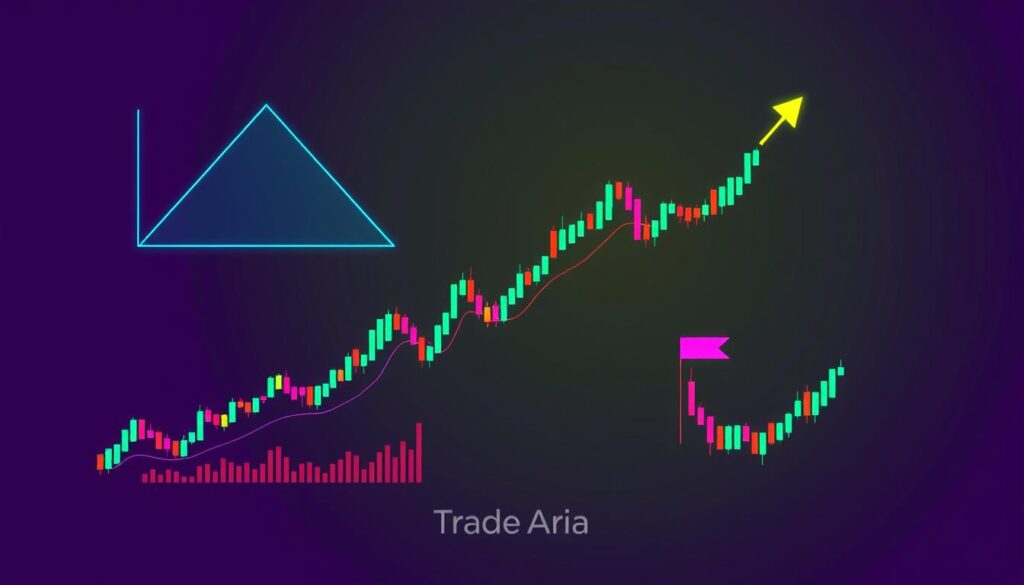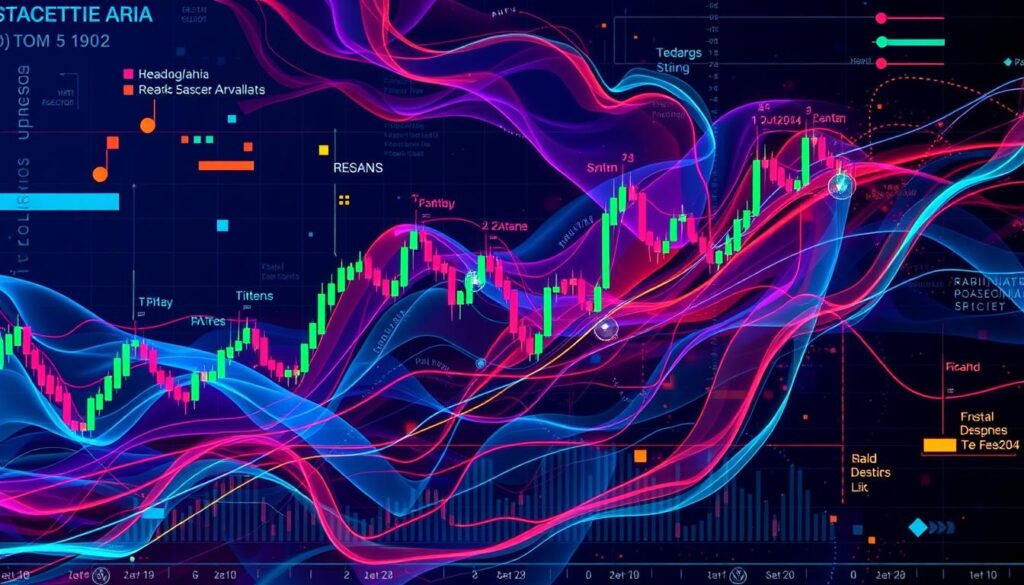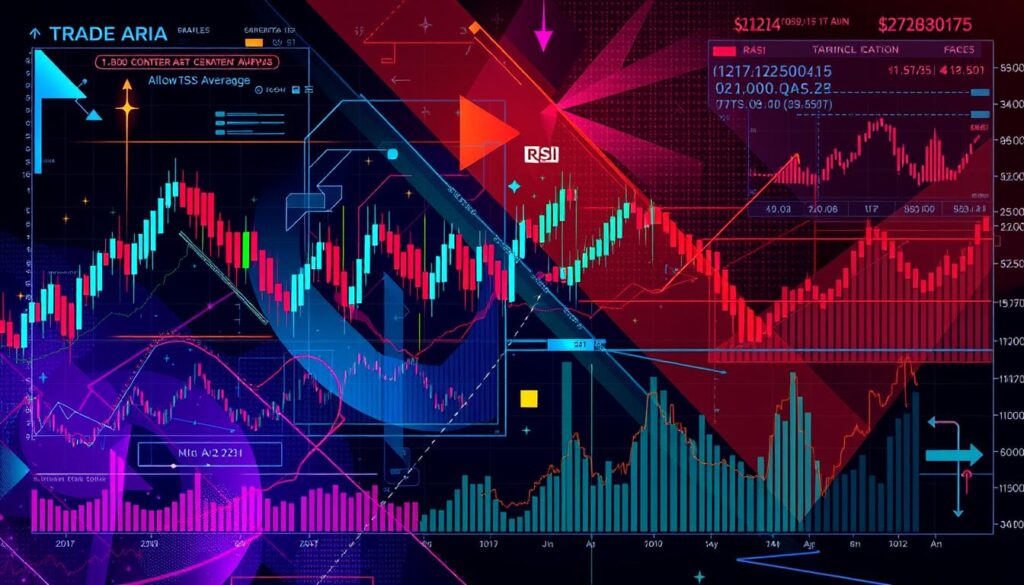Did you know the top magazine for technical analysis has been around since 1982? It offers over 64 pages of in-depth content. This guide is perfect for both new and experienced traders, ranking high in finance and investing.
Key Takeaways
- Learn the basics of technical analysis and how it applies to stocks and commodities.
- Discover key concepts like price action, trends, and support and resistance levels.
- Find out about popular technical indicators like moving averages and the Relative Strength Index (RSI).
- See how to read different chart types, including line, bar, and candlestick charts.
- Develop trading strategies with risk management and backtesting.
- Use various tools and resources to improve your technical analysis skills.
- Understand the differences between analyzing stocks and commodities for better decisions.
Understanding Technical Analysis: Basics and Benefits
Technical analysis is a key tool for traders and investors. It helps them understand the financial markets better. By looking at past prices and volumes, traders can spot patterns and trends. This knowledge helps them make better decisions and possibly improve their results.
What is Technical Analysis?
Technical analysis is about studying chart patterns, price action, and other market signs. It aims to predict future prices by analyzing past data. This method believes that past market actions can show what future actions might be.
Importance of Technical Analysis in Trading
Technical analysis is vital for traders. It helps them find the best times to buy or sell. By looking at past data, traders can see trends and understand market psychology. This knowledge guides their trading strategies.
Key Principles of Technical Analysis
- The market discounts everything: Technical analysts believe that all known and unknown information is already reflected in a security’s price.
- Prices move in trends: Technical analysis is based on the idea that markets tend to move in identifiable trends, which can be identified and exploited.
- History tends to repeat itself: Technical analysts believe that market behavior patterns often recur, allowing them to use historical data to predict future price movements.
By grasping these basic principles, traders can use technical analysis to their advantage. It helps them feel more confident in the financial markets. This can lead to better trading results.
Core Concepts of Technical Analysis
Technical analysis is key to understanding stock and commodity markets. It focuses on price action and trends, support and resistance levels, and volume analysis. These basics help traders and investors make smart choices.
Price Action and Trends
Price action shows how a security’s price changes over time. Knowing price trends is vital. Trends can be up, down, or sideways, showing market mood and future prices.
Support and Resistance Levels
Support and resistance levels are key price points. They mark where a stock or commodity might change direction. Spotting these levels helps predict market moves, aiding in trading strategies.
Volume Analysis
Volume analysis is important in technical analysis. It confirms price movements and trend strength. Volume shows market activity, offering insights into market psychology. It helps spot support or resistance and confirms trends.
Grasping these technical analysis basics boosts decision-making. It increases success in stock and commodity markets. Understanding trend lines, support and resistance, and volume indicators is crucial for technical analysis mastery.
Common Technical Indicators Explained
Traders looking for an edge in the markets find value in technical indicators. These tools analyze past trading data to spot buying and selling chances. Knowing common indicators helps traders make better choices and improve their strategies.
Moving Averages
Moving averages are key tools in trading. They smooth out price data to show the trend direction. Simple Moving Averages (SMA) and Exponential Moving Averages (EMA) are favorites, with EMA focusing more on recent data.
Relative Strength Index (RSI)
The Relative Strength Index (RSI) tracks price movement speed and change. It ranges from 0 to 100, showing when a market is overbought or oversold. RSI helps traders spot when to buy or sell, avoiding overbought or oversold technical indicators.
Bollinger Bands
Bollinger Bands have a middle band and two outer bands that adjust with volatility. They help spot price breakouts, reversals, and when the market is consolidating.
Understanding and using these technical indicators helps traders grasp market momentum. They can make trading decisions with more confidence. Adding these tools to a trading plan can boost performance.
Chart Types: Choosing the Right One
Choosing the right chart type is key in technical analysis. It helps you see price movements and trading patterns clearly. There are three main types: line charts, bar charts, and candlestick charts. Each has its own strengths, fitting different trader and investor needs.
Line Charts
Line charts are simple but powerful. They show price changes over time with a continuous line. They’re great for looking at long-term trends like housing starts or employment. Beginners and those wanting a simple view of trends often prefer them.
Bar Charts
Bar charts give a detailed look at price action. They show the open, high, low, and close prices for each period. This lets traders see the strength of buying and selling. They’re good for medium- to long-term analysis, showing a security’s history.
Candlestick Charts
Candlestick charts are a favorite among active traders. They show price movements in a clear, detailed way. The shape and color of each candlestick reveal market sentiment and potential changes. They’re best for short-term trading, helping spot patterns and signals.
When picking a chart type, think about your goals, the time frame, and the level of detail you need. Line charts are good for broad trends, bar charts for history, and candlestick charts for short-term trades. Learning about each type can improve your chart analysis, price visualization, and trading patterns skills.
How to Read Stock and Commodity Charts
Learning to read charts is key for traders and investors. It helps them understand the stock and commodity markets. By spotting patterns and knowing different time frames, you can make smart trading choices.
Identifying Patterns
Technical analysts look for patterns in charts. These patterns hint at future price changes. Common ones include head and shoulders, double tops and bottoms, and triangles.
Knowing these patterns helps you predict market moves. It’s like having a roadmap for the market.
Time Frames and Their Significance
- Intraday Timeframes: Charts for short periods show quick trends and chances to trade. But, they’re not as stable for long-term plans.
- Daily, Weekly, and Monthly Timeframes: Looking at bigger time frames helps spot reliable trends. It gives a clearer view of market cycles and chart reading.
For a deeper dive into chart patterns, check out “Encyclopedia of Chart Patterns” by Thomas Bulkowski. It’s packed with info on chart patterns and their success in predicting prices.
By knowing chart patterns and time frames, you can improve your chart reading skills. This helps you understand market cycles and pattern recognition better in the stock and commodity markets.
Developing a Trading Strategy
Making a good trading strategy is more than just looking at charts and indicators. It’s about setting clear goals, managing risks well, and testing your strategy. This whole approach is key for success in trading.
Setting Goals and Objectives
The first thing to do is set your goals. They should be specific, measurable, achievable, relevant, and time-bound (SMART). Your goals could be to make a certain amount of money, have a certain win rate, or keep losses small. Clear goals help you stay focused and motivated.
Risk Management Techniques
Good risk management is vital for a successful strategy. This means using stop-loss orders, managing how much you risk per trade, and spreading your investments. It’s wise to risk no more than 1% of your account per trade. Day traders might stop for the day if they lose 3% of their account. Swing traders might take a week off if they lose 20%.
Backtesting Your Strategy
- Testing your strategy on past data is key to see if it works. This checks how well it does in different market conditions, even in tough times.
- When testing, pick the right amount of past data, use accurate prices, and look at many market scenarios.
- The expectancy formula helps figure out your strategy’s edge. It looks at win rate, average win, and average loss.
By setting clear goals, managing risks well, and testing your strategy, you can make a plan that fits your risk level and trading style. This detailed approach is crucial for success in the markets.
Tools and Resources for Technical Analysis
As a trader, the right tools can change the game. Today, there’s a lot of software, platforms, and resources for technical analysis. These tools help traders of all levels improve and stay ahead.
Software and Platforms
There are many trading software and platforms out there. Brokerages like Trading Central, StreetSmart Edge by Charles Schwab, and E*TRADE’s Power E*TRADE offer great features. They have customizable charts, live scanners, and technical indicators to spot trends.
Platforms like Fidelity’s Active Trader Pro, Interactive Brokers’ Trader Workstation, and TradeStation also offer strong technical tools. They have automated charts, pattern recognition, and backtesting. These tools are for traders at any level.
Online Communities and Forums
The internet has many online communities and forums for traders. Sites like TradingView and Benzinga Pro offer real-time data, market commentary, and educational materials. These platforms are great for sharing insights and learning.
Books and Publications
For a deeper dive into technical analysis, there are many books and publications. “Technical Analysis Using Multiple Timeframes” by Brian Shannon is a classic. It covers analyzing price movements across different time frames. These resources are key for expanding your knowledge and improving your strategies.
Using the right tools and resources can greatly improve your technical analysis skills. Whether you’re new or experienced, these resources can help you succeed in the market. They’re essential for reaching your financial goals.
Analyzing Stocks vs. Commodities: Key Differences
Technical analysis works for both stocks and commodities, but they have key differences. Knowing these differences is vital for traders. It helps them use technical analysis well in different markets.
Market Characteristics
Stocks are mainly affected by a company’s performance and the economy. Stock market analysis looks at things like revenue and earnings. On the other hand, commodity trading is influenced by supply and demand, and things like weather and politics.
Influencing Factors
- Stocks are affected by news about the company, the industry, and the economy.
- Commodities are more influenced by physical factors like production and global trade.
- Stocks show a company’s true value. Commodities are driven by supply and demand.
It’s important for traders to know these differences. By understanding the unique market characteristics and influencing factors of stocks and commodities, they can make better trading plans.
Real-World Applications of Technical Analysis
This section looks at how technical analysis works in real trading. We’ll see examples from stock and commodity markets. These examples show how technical strategies help in the fast-changing financial world.
Case Studies in Stock Trading
In stock trading, technical analysis is very useful. It helps find good times to buy and sell. For example, a trader used support and resistance levels and moving averages to make smart trades in a tech stock. This led to big profits over months.
Another example is using chart patterns in the healthcare sector. A trader spotted a head and shoulders pattern, which showed a price drop was coming. They made money by short selling before the price fell.
Case Studies in Commodity Trading
Technical analysis also works well in commodity markets. For instance, a gold trader used Fibonacci levels to find support zones. This helped them make money as gold prices went up.
In the wheat futures market, a trader looked at volume and on-balance volume. They found strong buying times to make long positions. This strategy worked well with wheat’s price cycles.
FAQ
What is technical analysis?
Technical analysis looks at market activity to predict future prices. It uses past prices and volume to spot trends and market mood. This helps traders know when to buy or sell.
Why is technical analysis important in trading?
It’s key because it shows trends and market feelings. It uses past data to guess future moves. This helps traders make smart choices.
What are the core concepts of technical analysis?
Key ideas include price movements, trends, and support and resistance levels. Volume analysis is also crucial. These help understand market shifts.
What are some common technical indicators used in stock and commodity analysis?
Indicators like moving averages and Relative Strength Index (RSI) are common. Bollinger Bands are also used. They help spot trends and market swings.
What are the different types of charts used in technical analysis?
Main charts are line, bar, and candlestick charts. Each shows price changes differently. They offer unique views of the market.
How do I effectively read and interpret stock and commodity charts?
Reading charts well means spotting patterns and understanding time frames. Look for head and shoulders, double tops, and triangles. They show important market shifts.
What are the key elements of developing a successful trading strategy?
A good strategy sets clear goals and manages risk. It’s tested on past data to see if it works. This ensures it’s effective.
What tools and resources are available for technical analysis?
Many tools and resources exist, like software and online forums. These are recognized for their quality. They help traders improve their skills.
How do the characteristics and influencing factors differ between stocks and commodities?
Stocks are shaped by company performance and economic trends. Commodities are influenced by supply and demand, weather, and politics. These differences affect their prices.
Can you provide examples of how technical analysis is applied in real-world trading?
This guide shares real examples of traders using technical tools. It shows how they make money with chart patterns and indicator signals. It’s based on actual market experiences.






Fascinating blog! Is your theme custom made or did you download it from somewhere?
A design like yours with a few simple adjustements would really make my blog shine.
Please let me know where you got your theme.
With thanks